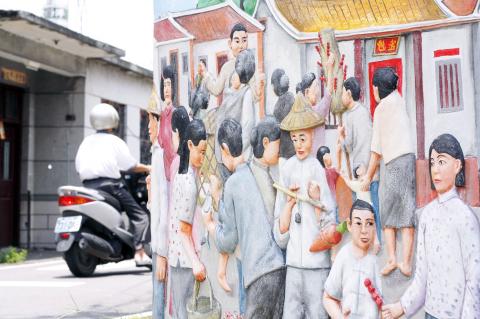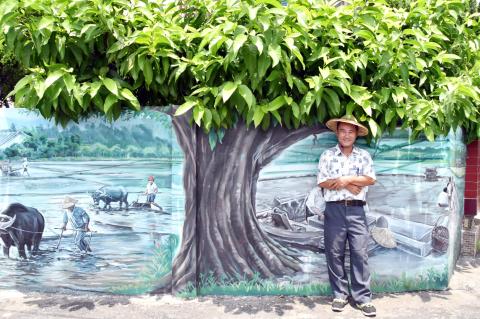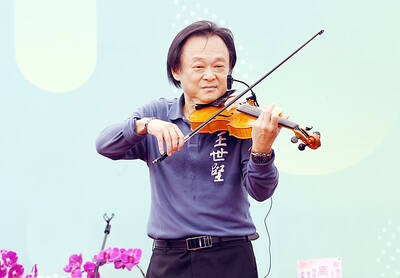Erlun Village in Pingtung County used to be the local township administration center during the Japanese colonial era, but that role was later replaced by Jhutian Village, ending Erlun’s days of glory. Erlun villagers became more and more closed-minded. For years, weeds grew along the walls and corners of the village. People stopped caring about one another and allowed even the most inconsequential things to cause disputes.
Village Warden Li I-jen says that “Erlun,” when pronounced in Hakka, sounds like “argument.” It is quite common for Erlun villagers to have arguments or quarrels with one another over things like the neighbor’s dog barking too loudly, somebody’s car not being parked properly or someone’s weeds not being tidied up regularly. These disputes could even end up in a mediation committee. In his nearly 10 years as village warden, Li’s highest record is settling four disputes in one day.
Since the community development association obtained funds and invited artists to work in the village, 10 walls of various sizes have been redesigned, and the originally bleak corners have also been brightened up with lively colorful paintings.

Photo: Chiu Chih-jou, Liberty Times
照片:自由時報記者邱芷柔
The murals in Erlun Village mostly depict bustling scenes from the village’s past and life in the countryside. Li said that not only has the village recently seen more tourists visiting, but the villagers also have started helping each other. Mediation cases have been greatly reduced, as if the murals had brought out shared memories that join people together, he says.
(Liberty Times, translated by Ethan Zhan)

Photo: Chiu Chih-jou, Liberty Times
照片:自由時報記者邱芷柔
屏東縣二崙村在日治時代前是當地的行政中心,後來行政中心轉往現在的竹田村,二崙村繁榮景象不再,村民越來越封閉,多年來社區牆面、角落都雜草叢生,大家自掃門前雪,連芝麻小事都要計較。
二崙村村長李毅仁說,「二崙」的客家話與「議論」發音相同,而住在二崙村的村民常有議論、紛爭情形,隔壁的狗太吵、車子沒停好、雜草沒整理都能鬧上調解會,他當村長近十年期間,最高紀錄一天就要處理四件調解案。
經過社區發展協會爭取經費,邀請藝術家下鄉後,目前社區有十面大小不一的牆面被換上新裝,原本黯淡的角落也因為生動活潑的彩繪變得明亮。
二崙村內的壁畫,多以描繪二崙村過去繁榮景象與農村生活為主。李毅仁說,最近不僅觀光客變多了,村民也開始互相幫忙,調解案件量大大減少,就像是壁畫牽起大家共同記憶一樣。
(自由時報記者邱芷柔)

A: Apart from the world’s major dictionaries, the online Dictionary.com actually picked “67” as its word of the year. B: What does “67” even mean? A: Even the dictionary wasn’t exactly sure about its meaning. The slang term’s origin might be traced to US rapper Skrilla’s song Doot Doot (67). Aren’t Taiwanese media outlets choosing the Mandarin word for 2025? B: Yeah and after hearing the song Good-for-Nothing, adapted from some catchphrases of Legislator Wang Shih-chien, I’m going to vote for the character “tsung” (hasty) from the lyrics. A: Hopefully, in the new year, we’ll be calm as the

Sea star wasting disease (SSWD) is a strange and serious illness affecting sea stars, or starfish. This disease causes sea stars to develop painful lesions, lose their arms, and eventually turn into a gooey, melted mess. Since it was first observed in 2013, millions of sea stars along the Pacific coast of North America have died from this __1__. Although viruses were once considered a possible cause, researchers now believe that environmental stressors and microorganisms are primarily __2__ for sea star wasting disease. One of the main environmental triggers appears to be warmer ocean water. When the water heats

For many people in Taiwan, childhood memories of rural life include pig pens standing beside family homes. Leftover rice, vegetable scraps and soup from daily meals were poured into buckets and fed to pigs. This practice of feeding pigs with household food waste was once a common way of life, both an economic choice and an expression of agricultural society’s deep respect for conserving resources. From a practical standpoint, pigs are omnivorous animals capable of efficiently digesting food scraps that humans can no longer eat. For rural households, food waste cost almost nothing, yet it could be converted into pork, a

1. 我是2021年受傷的。 ˇI was wounded in 2021. χ I wounded in 2021. 註:「受傷」在英文應用被動語態。 2. 全國各地成立了許多讀書會。 ˇMany reading groups have been established all over the country. χ Many reading groups have established all over the country. 註:組織由人「成立」,應使用被動語態。 3. 這些目標一定能超越。 ˇ These targets are bound to be surpassed. χ These targets are bound to surpass. 註:surpass 作「超越」解。中文原句中沒有明顯被動語態,但英文必須使用被動式 be surpassed。類似的還有 “… goals are sure to be achieved.”,不說 “… goals are sure to achieve”。 4. 他一點也不驚訝。 ˇHe was not at all surprised. χ He did not surprise at all. 註:surprise 「驚訝」應使用被動語態,中文原句中沒有明顯被動語態。 5. 我國自 2018 年起擺脫了口蹄疫。 ˇOur country has been free from foot-and-mouth disease since 2018. χ Our country has freed foot-and-mouth disease since 2018. 註: 「受傷」、「成立」、「超越」、「驚訝」及「擺脫」等在中文原句中好像並非被動語態,許多人受中文影響,在用英語表達時也用主動語態,是不對的。 Exercises A. 他一點也不適合這個職位。 He is not __________